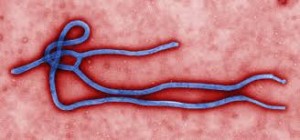Ebola and Availability Cascades

We can’t see it so it must be everywhere!
Which causes more deaths: strokes or accidents?
The way you consider this question speaks volumes about how humans think. When we don’t have data at our fingertips (i.e., most of the time), we make estimates. We do so by answering a question – but not the question we’re asked. Instead, we answer an easier question.
In fact, we make it personal and ask a question like this:
How easy is it for me to retrieve memories of people who died of strokes compared to memories of people who died by accidents?
Our logic is simple: if it’s easy to remember, there must be a lot of it. If it’s hard to remember, there must be less of it.
So, most people say that accidents cause more deaths than strokes. Actually, that’s dead wrong. As Daniel Kahneman points out, strokes cause twice as many deaths as all accidents combined.
Why would we guess wrong? Because accidents are more memorable than strokes. If you read this morning’s paper, you probably read about several accidental deaths. Can you recall reading about any deaths by stroke? Even if you read all the obituaries, it’s unlikely.
This is typically known as the availability bias – the memories are easily available to you. You can retrieve them easily and, therefore, you overestimate their frequency. Thus, we overestimate the frequency of violent crime, terrorist attacks, and government stupidity. We read about these things regularly so we assume that they’re common, everyday occurrences.
We all suffer from the availability bias. But when we suffer from it simultaneously and together, it can become an availability cascade – a form of mass hysteria. Here’s how it works. (Timur Kuran and Cass Sunstein coined the term availability cascade. I’m using Daniel Kahneman’s summary).
As Kahneman writes, an “… availability cascade is a self-sustaining chain of events, which may start from media reports of a relatively minor incident and lead up to public panic and large-scale government action.” Something goes wrong and the media reports it. It’s not an isolated incident; it could happen again. Perhaps it could affect a lot of people. Perhaps it’s an invisible killer whose effects are not evident for years. Perhaps you already have it. How would one know? Or perhaps it’s a gruesome killer that causes great suffering. Perhaps it’s not clear how one gets it. How can we protect ourselves?
Initially, the story is about the incident. But then it morphs into a meta-story. It’s about angry people who are demanding action; they’re marching in the streets and protesting in front of the White House. It’s about fear and loathing. Then experts get involved. But, of course, multiple experts never agree on anything. There are discrepancies in the stories they tell. Perhaps they don’t know what’s really going on. Perhaps they’re hiding something. Perhaps it’s a conspiracy. Perhaps we’re all going to die.
A story like this can spin out of control in a hurry. It goes viral. Since we hear about it every day, it’s easily available to our memories. Since it’s available, we assume that it’s very probable. As Kahneman points out, “…the response of the political system is guided by the intensity of public sentiment.”
Think it can’t happen in our age of instant communications? Go back and read the stories about ebola in America. It’s a classic availability cascade. Chris Christie, the governor of New Jersey, reacted quickly — not because he needed to but because of the intensity of public sentiment. Our 24-hour news cycle needs something awful to happen at least once a day. So availability cascades aren’t going to go away. They’ll just happen faster.
2 Responses to Ebola and Availability Cascades
-
Pingback: Reality Is A Conspiracy | Travis White Communications
-
Pingback: Trumping The Press | Travis White Communications